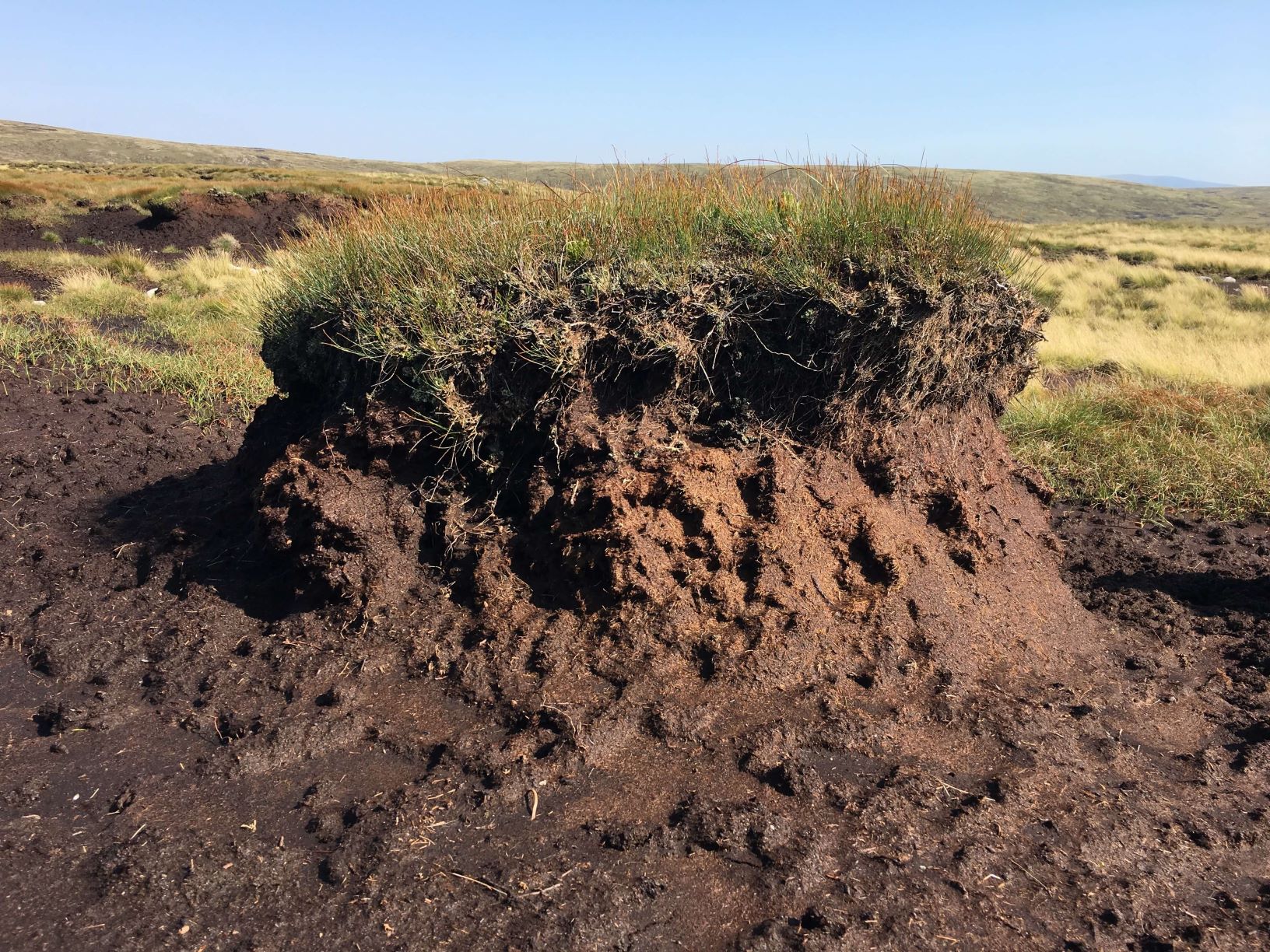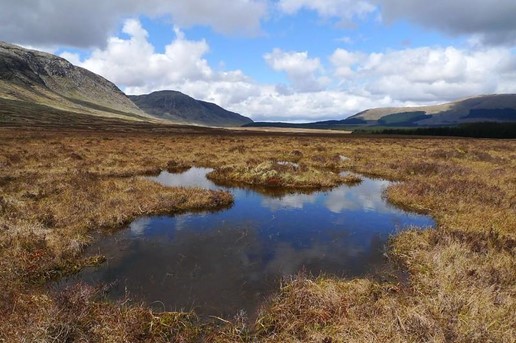Last updated: 08/2024
Functioning peatland ecosystems are some of the most carbon-rich terrestrial ecosystems on earth, storing up to 30 times more carbon per hectare than a healthy tropical rainforest. Globally peatlands lock up an estimated 550 billion tonnes of CO2e. To put this figure into context, the entirety of global CO2 emissions in 2019 was 36.44 billion metric tonnes.
Peatlands in the UK
In the UK, as a result of decades of land management practices that have disrupted ecosystem processes, 80% of peatlands are degraded. Where peatlands could be an effective natural carbon sink, UK peatlands are currently emitting vast quantities of CO2 into the atmosphere, accounting for at least 3.5% of the UK’s total emissions.
The Office for National Statistics estimates that fully restoring the UK’s degraded peatlands could cost between £8-22bn over the next 100 years, but would save £109bn in terms of reduced carbon emissions alone.
On this page, we will cover some of the key information about UK peatlands.
What is a peatland?
Peatlands, or mires, are waterlogged ecosystems, which capture carbon over long periods of time by preventing the decomposition of plant matter. Due to a lack of oxygen, the carbon captured during photosynthesis is not released back into the atmosphere, being stored instead in the soils as peat. There are three main types of peatland in the UK including blanket bog, raised bog and fens. However, there are also many peatland-woodland intermediate habitats that naturally occur, like bog woodland or wetland scrub.
 Bog woodland is a common, naturally occurring habitat in cool, high-latitude climates. A high water table suppresses tree growth on the peatland, leading to stunted and widely-spaced trees.
Bog woodland is a common, naturally occurring habitat in cool, high-latitude climates. A high water table suppresses tree growth on the peatland, leading to stunted and widely-spaced trees.
Three types of bogs
- Blanket Bog: a type of highly acidic peatland found in locations with cool, wet and usually oceanic climates. Usually found above 1000ft in the UK.
- Raised Bog: Mostly found within lowland landscapes. Few raised bogs remain intact in the UK and most are found in nature reserves. A raised bog can be several meters higher than surrounding land level and is vegetated by characteristic bog species. These include cotton grasses, mosses, heather, cross-leaved heath, bog asphodel and deer-grass. Turf cutting, drainage and afforestation has resulted in the loss of 94% of the raised bogs in Britain, and 99% in Ireland.
- Fens: Naturally marshy regions, fed by mineral rich surface water or groundwater. Fens have a neutral or slightly alkaline pH, with high levels of dissolved minerals. Characteristic species include reeds, robust tall-herbs or tussocky sedge grass.
Watch this short 3-minute video: ‘The Extraordinary Story of Peat and Carbon’, which explains why the carbon storage process in peatlands is so effective.
Why are UK peatlands degraded?
As a result of decades of intensive land management practices including drainage, arable farming, atmospheric pollution, peat extraction, muirburn and overgrazing - 80% of peatlands in the UK are currently damaged, drying out and oxidising, releasing vast quantities of greenhouse gases (GHGs) that had been locked up for hundreds or even thousands of years.
In fact, in 2017 it was estimated that UK peatlands emitted an estimated 23 million tonnes of CO2e each year, roughly 5% of the UK’s net territorial greenhouse gas emissions that year.
Preventing further damage to our peatlands and restoring their healthy functioning is therefore critical if the UK is to hit its climate targets. For example, the carbon locked up in Scottish peatland soils is equivalent to 140 years’ worth of Scotland’s total annual greenhouse gas emissions.
How can you tell if a peatland is degraded?
Signs a peatland is degraded:
Erosion: this remaining tuft of peat shows the previous ground level. The peat around it has been eroded away completely.
Bare peat: this peat is open to the air, leading to oxidation of the carbon stored in the peat.
Absence: there is no sign of peat-forming vegetation, such as sphagnum mosses.

Signs a peatland is healthy and functioning:
Waterlogged ground due to a high water table.
Diversity of peat-forming and other vegetation types, each supporting an array of associated species.

What is peat used for today?
Gardeners who are using multi-purpose compost, both for individual and commercial purposes, may be unaware that these products contain up to 90% peat. It’s been used by commercial growers and at-home gardeners since the mid-20th century.
A ban on peat-containing products was meant to come into effect in 2024, however, the UK government has recently confirmed that “while some peat-containing products will be banned from shelves in 2027, others will be exempt from a ban until 2030.” Wildlife Trust
Despite peat-free compost alternatives existing, in 2022, the UK was the 10th largest importer of peat in the world, primarily from Ireland and the Netherlands. On average, annual UK peat sales would fill 29,000 large shipping containers and could release up to 850,000 tonnes of CO2.
Burning peat as a fuel also still exists, especially in island communities where firewood is not easily accessible.
Peatland biodiversity
Healthy peatland ecosystems play host to a biodiverse ecosystem of mosses, insects, moths, amphibians, reptiles, flowering plants, fungi, birds, and butterflies. A lowland bog may hold over 3000 insect species, 800 flowering plants and hundreds of types of mosses creating a rich ecological fabric.
Sphagnum mosses are the keystone bog species, in part because they can hold 20 times their dry weight in water, ensuring the ground remains waterlogged most of the time. In terms of the carbon stored, a 15cm layer of living sphagnum can hold up to 50 tonnes of carbon per hectare.
Peatland species of conservation priority in Scotland include: carrion moss, the money-spider, adder, Haworth’s minor moth, mountain hare, marsh honey fungus, juniper, heath spotted orchid, large heath butterflies, black-throated diver, greater scaup, skylarks and the common toad (to name just a few!)
How can you help?
Forest Carbon currently has two peatland restoration projects where carbon is available for purchase:
1. Cùl Mòr, Scottish Highlands
2. Duich Moss, Islay
Restoration of peatlands is a costly process. We are working to address this problem by involving corporate and private investors who want to cover these critical costs, enabling land managers to kick-start restoration efforts.
If you are interested in peatland restoration or investment, please get in touch.
Read more about how peatland carbon offsets are validated and verified here.